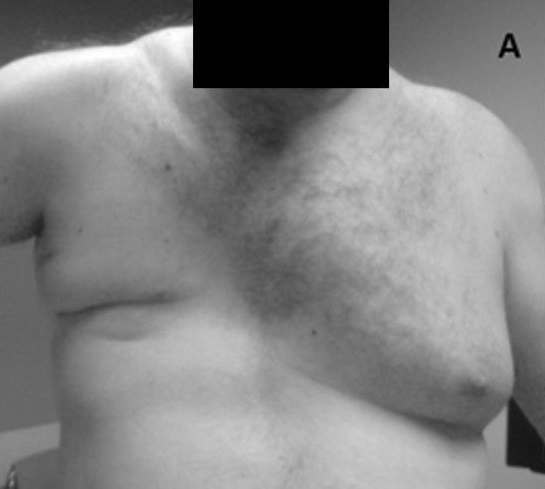[1]
Romanini MV, Calevo MG, Puliti A, Vaccari C, Valle M, Senes F, Torre M. Poland syndrome: A proposed classification system and perspectives on diagnosis and treatment. Seminars in pediatric surgery. 2018 Jun:27(3):189-199. doi: 10.1053/j.sempedsurg.2018.05.007. Epub 2018 Jun 8
[PubMed PMID: 30078491]
Level 3 (low-level) evidence
[2]
Mühlbauer W, Wangerin K. [Embryology and etiology of the Poland and Amazone syndromes]. Handchirurgie. 1977:9(3):147-52
[PubMed PMID: 204553]
[3]
Slezak R, Sasiadek M. [Poland's syndrome]. Polski merkuriusz lekarski : organ Polskiego Towarzystwa Lekarskiego. 2000 Aug:9(50):568-71
[PubMed PMID: 11081328]
[4]
Romanini MV,Torre M,Santi P,Dova L,Valle M,Martinoli C,Baldelli I, Proposal of the TBN Classification of Thoracic Anomalies and Treatment Algorithm for Poland Syndrome. Plastic and reconstructive surgery. 2016 Jul;
[PubMed PMID: 27348639]
[5]
Al-Qattan MM. Classification of hand anomalies in Poland's syndrome. British journal of plastic surgery. 2001 Mar:54(2):132-6
[PubMed PMID: 11207123]
[6]
Majdak-Paredes EJ, Shafighi M, Fatah F. Integrated algorithm for reconstruction of complex forms of Poland syndrome: 20-year outcomes. Journal of plastic, reconstructive & aesthetic surgery : JPRAS. 2015 Oct:68(10):1386-94. doi: 10.1016/j.bjps.2015.05.015. Epub 2015 May 28
[PubMed PMID: 26159469]
[7]
Beer GM, Kompatscher P, Hergan K. Poland's syndrome and vascular malformations. British journal of plastic surgery. 1996 Oct:49(7):482-4
[PubMed PMID: 8983554]
[9]
Gui L, Shen S, Mei W. Anaesthesia for chest wall reconstruction in a patient with Poland syndrome: CARE-compliant case report and literature review. BMC anesthesiology. 2018 May 24:18(1):57. doi: 10.1186/s12871-018-0518-4. Epub 2018 May 24
[PubMed PMID: 29793431]
Level 3 (low-level) evidence
[10]
Al Faleh K, Al Saadi M, Khalid-Bantuas S. Poland's Syndrome with Absent Limb Anomalies. Journal of clinical neonatology. 2014 Jan:3(1):44-6. doi: 10.4103/2249-4847.128735. Epub
[PubMed PMID: 24741541]
[11]
Lacorte D, Marsella M, Guerrini P. A case of Poland Syndrome associated with dextroposition. Italian journal of pediatrics. 2010 Feb 20:36():21. doi: 10.1186/1824-7288-36-21. Epub 2010 Feb 20
[PubMed PMID: 20170539]
Level 3 (low-level) evidence
[12]
Baas M,Burger EB,Sneiders D,Galjaard RH,Hovius SER,van Nieuwenhoven CA, Controversies in Poland Syndrome: Alternative Diagnoses in Patients With Congenital Pectoral Muscle Deficiency. The Journal of hand surgery. 2018 Feb;
[PubMed PMID: 29033291]
[13]
Fijałkowska M, Antoszewski B. Surgical treatment of patients with Poland's syndrome--own experience. Polski przeglad chirurgiczny. 2011 Dec:83(12):662-7. doi: 10.2478/v10035-011-0106-5. Epub
[PubMed PMID: 22343203]
[15]
Freitas Rda S, o Tolazzi AR, Martins VD, Knop BA, Graf RM, Cruz GA. Poland's syndrome: different clinical presentations and surgical reconstructions in 18 cases. Aesthetic plastic surgery. 2007 Mar-Apr:31(2):140-6
[PubMed PMID: 17093886]
Level 3 (low-level) evidence
[17]
Pinsolle V, Chichery A, Grolleau JL, Chavoin JP. Autologous fat injection in Poland's syndrome. Journal of plastic, reconstructive & aesthetic surgery : JPRAS. 2008 Jul:61(7):784-91. doi: 10.1016/j.bjps.2007.11.033. Epub 2008 Feb 21
[PubMed PMID: 18178141]
[18]
Baratte A,Bodin F,Del Pin D,Wilk A,Bruant C, [Poland's syndrome in women: Therapeutic indications according to the grade. Apropos of 11 cases and review of the literature]. Annales de chirurgie plastique et esthetique. 2011 Feb;
[PubMed PMID: 21292378]
Level 3 (low-level) evidence
[19]
Fekih M, Mansouri-Hattab N, Bergaoui D, Chaieb A, Fikry T, Khairi H. [Correction of breast Poland's anomalies. About eight cases and literature review]. Annales de chirurgie plastique et esthetique. 2010 Jun:55(3):211-8. doi: 10.1016/j.anplas.2009.06.003. Epub 2009 Oct 29
[PubMed PMID: 19879029]
Level 3 (low-level) evidence
[20]
Chavoin JP, Taizou M, Moreno B, Leyx P, Grolleau JL, Chaput B. Correcting Poland Syndrome with a Custom-Made Silicone Implant: Contribution of Three-Dimensional Computer-Aided Design Reconstruction. Plastic and reconstructive surgery. 2018 Aug:142(2):109e-119e. doi: 10.1097/PRS.0000000000004605. Epub
[PubMed PMID: 30045173]
[21]
Hodgkinson DJ. Chest wall implants: their use for pectus excavatum, pectoralis muscle tears, Poland's syndrome, and muscular insufficiency. Aesthetic plastic surgery. 1997 Jan-Feb:21(1):7-15
[PubMed PMID: 9204161]
[22]
Jansari M,Karkhanis V,Joshi JM, Unilateral hyperlucent lung: Always think ACROSS. Lung India : official organ of Indian Chest Society. 2013 Oct;
[PubMed PMID: 24339504]
[23]
Losken A, Fishman I, Denson DD, Moyer HR, Carlson GW. An objective evaluation of breast symmetry and shape differences using 3-dimensional images. Annals of plastic surgery. 2005 Dec:55(6):571-5
[PubMed PMID: 16327452]
[24]
Caouette-Laberge L, Borsuk D. Congenital anomalies of the breast. Seminars in plastic surgery. 2013 Feb:27(1):36-41. doi: 10.1055/s-0033-1343995. Epub
[PubMed PMID: 24872738]
[25]
Sunitha VC, Narayanan S, Nair PP, Prakash ML. Left-sided Poland's syndrome in a girl with rare associations like spina bifida and diaphragmatic hernia. BMJ case reports. 2013 Sep 20:2013():. doi: 10.1136/bcr-2013-200930. Epub 2013 Sep 20
[PubMed PMID: 24057335]
Level 3 (low-level) evidence
[27]
Scheflan M, Kalisman M. Complications of breast reconstruction. Clinics in plastic surgery. 1984 Apr:11(2):343-50
[PubMed PMID: 6233063]
[28]
Baldelli I, Santi P, Dova L, Cardoni G, Ciliberti R, Franchelli S, Merlo DF, Romanini MV. Body Image Disorders and Surgical Timing in Patients Affected by Poland Syndrome: Data Analysis of 58 Case Studies. Plastic and reconstructive surgery. 2016 Apr:137(4):1273-1282. doi: 10.1097/PRS.0000000000002018. Epub
[PubMed PMID: 27018681]
Level 3 (low-level) evidence

